Next Generation Web Applications and Their Impact on International Business
Next Generation Web Applications and Their Impact on International Business
In today's connected world, international businesses succeed or struggle based on their digital skills. They must adapt to web development trends. Fast, scalable and user-centric web applications are most critical. Web app development changes quickly. Next-gen web apps change how companies connect with customers worldwide. They also help teams work together across borders and stay ahead of competitors.
The Evolution of Web Application Development
Understanding the web application development process and its roots reveals its trajectory. Web applications developed from simple static web pages using basic HTML to dynamic platforms powered by the cloud.
From Web 1.0 to Web 3.0:
Web 1.0 (1990s): Static "brochure" sites. Example: Early corporate pages displaying contact info. No interactive user interfaces.
Web 2.0 (2000s): Rise of social media platforms (Facebook) and tools like Google Docs. We enabled dynamic content and user comments. Added real-time collaboration using PHP and relational databases.
Web 3.0 (Present): Decentralized, AI-driven web-based applications. Example: Blockchain marketplaces enabling cross-border contracts without intermediaries.
The Rise of JavaScript Frameworks, SPAs, and APIs
JavaScript frameworks (React, Angular, Vue.js) gave birth to Single Page Applications (SPAs). Gmail shows this well. Messages load right away without refreshing the page, giving it a feel like a mobile app
Application Programming Interfaces (APIs) became digital "bridges." Example: Booking.com uses payment gateway APIs to process transactions in 40+ currencies
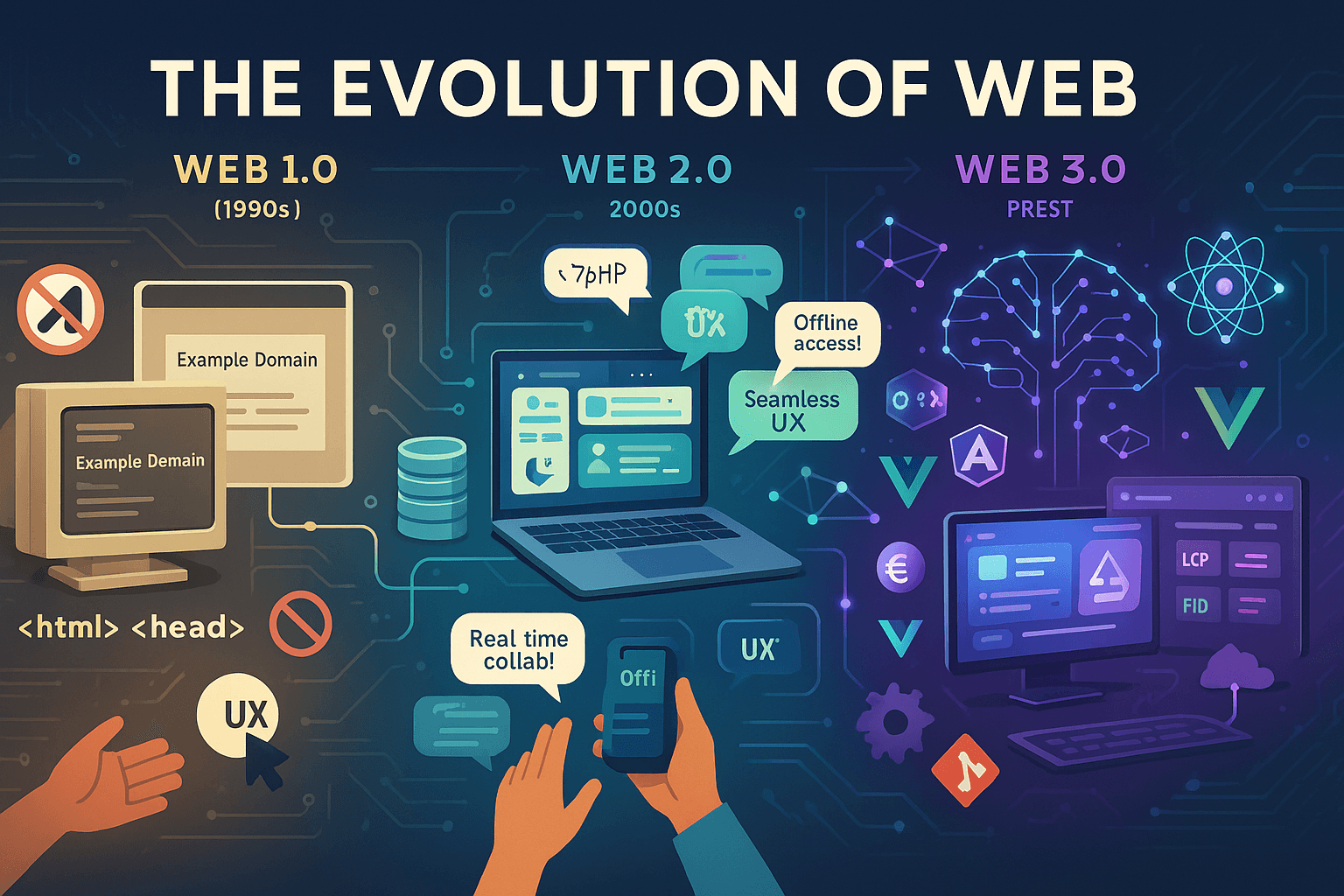
How user expectations shaped practices
Users wanted Google Docs-like features: real-time collaboration, offline access and a smooth experience
This forced web developers to:
Adopt web application development frameworks (Django, Ruby on Rails) for rapid development
Prioritize core web vitals (loading speed, responsiveness) to boost search engine results rankings
Implement version control systems (Git) for team collaboration
Core Technologies Behind Modern Web App Development
Understanding web application development roots and the importance of developing websites reveals its trajectory. Web applications changed from simple static web pages to dynamic, cloud-based platforms, showcasing the evolution of web technologies.
Front-End: React, Angular, Vue.js
The front-end shapes the user interface (UI) that customers interact with.
JavaScript frameworks like React (Meta), Angular (Google), and Vue.js help web developers build interactive user interfaces.
Real-world impact:
Airbnb uses React to provide a smooth experience on mobile devices, tablets, and desktops
Google Ads employ Angular for real-time analytics dashboards with dynamic content.
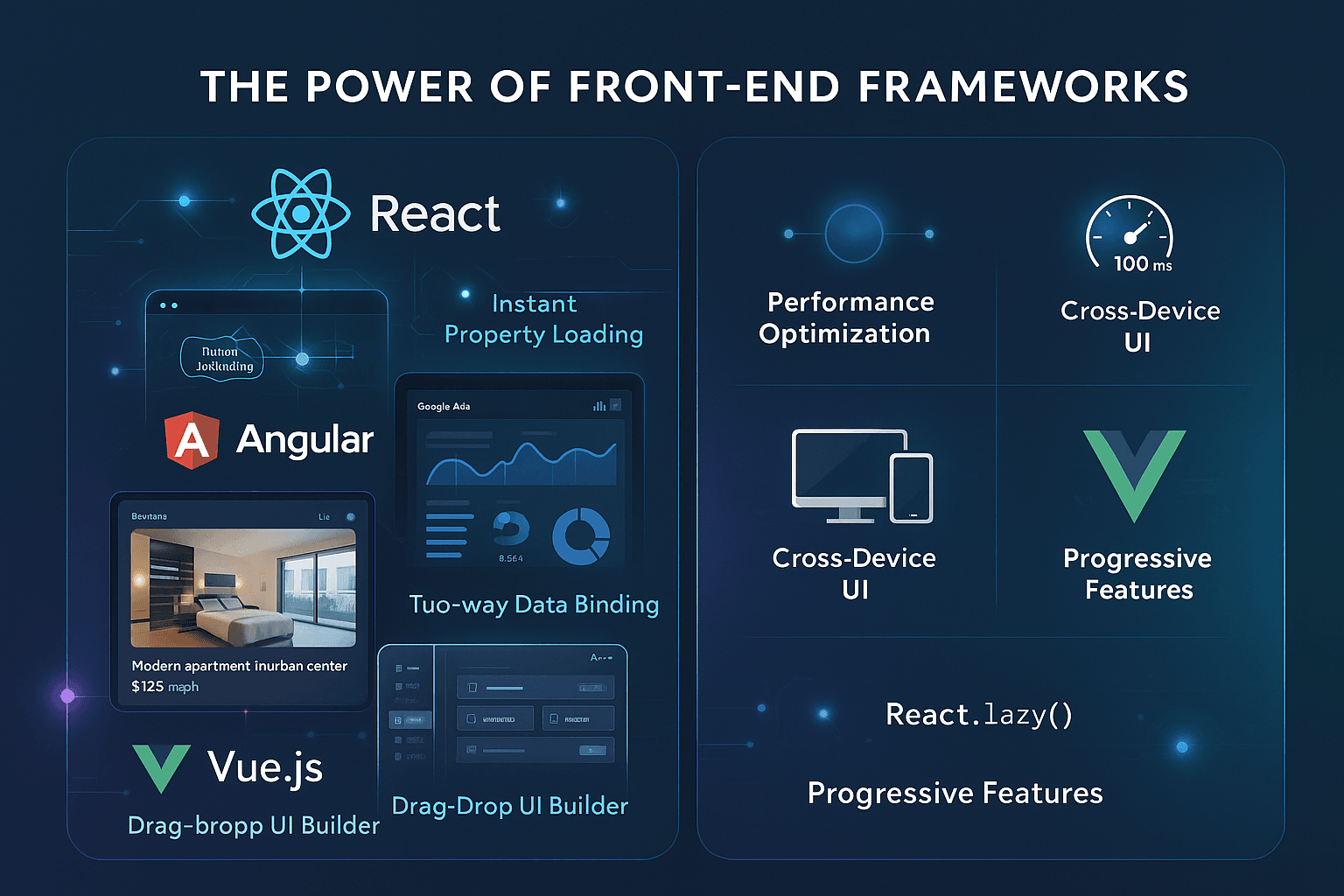
Key advantages:
Design interfaces that allow users to easily arrange interactive elements through drag-and-drop functionality
Ensure performance optimization for slow networks (critical in emerging markets)
Support progressive JavaScript framework features like lazy loading
Back-End: Node.js, Django, Flask and Python Web Development
The back-end handles server-side operations and business logic.
Server-side programming languages:
Tool
Use Case
Strength
Node.js
LinkedIn messaging (handles 10M+ concurrent chats)
High-speed I/O operations
Django (Python)
Instagram’s user authentication and content feeds
Batteries-included web application framework
Flask (Python)
Pinterest API endpoints
Lightweight customization
Database management:
Relational databases (PostgreSQL, MySQL) ensure data integrity for financial transactions
Python web development simplifies backend development to manage data flows
Example: Netflix uses Node.js to serve personalized show recommendations in milliseconds
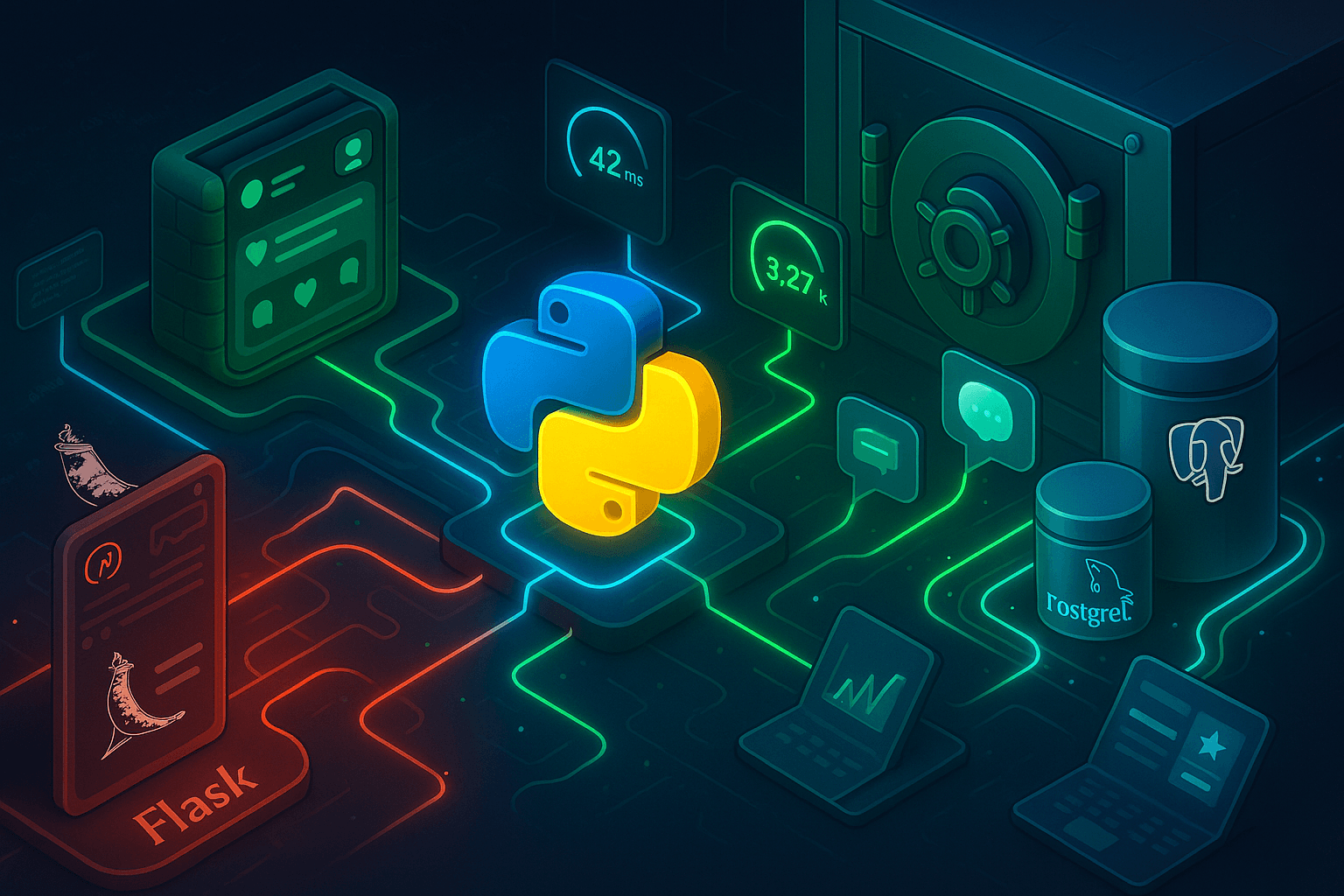
Cloud Services: AWS, Firebase, Azure
Cloud infrastructure replaces physical web servers, enabling borderless scalability.
1. AWS (Amazon Web Services)
Best For: Enterprise scalability (handling large-scale business needs)
Global Impact: Hosts 65% of Netflix’s streaming, serving 190 countries
2. Azure (Microsoft)
Best For: Hybrid cloud solutions (mixing public and private cloud)
Global Impact: Powers BMW’s factory coordination across 30 nations
3. Firebase (Google)
Best For: Real-time apps (apps needing instant updates, like chat apps)
Global Impact: Runs Alibaba’s cross-border inventory updates
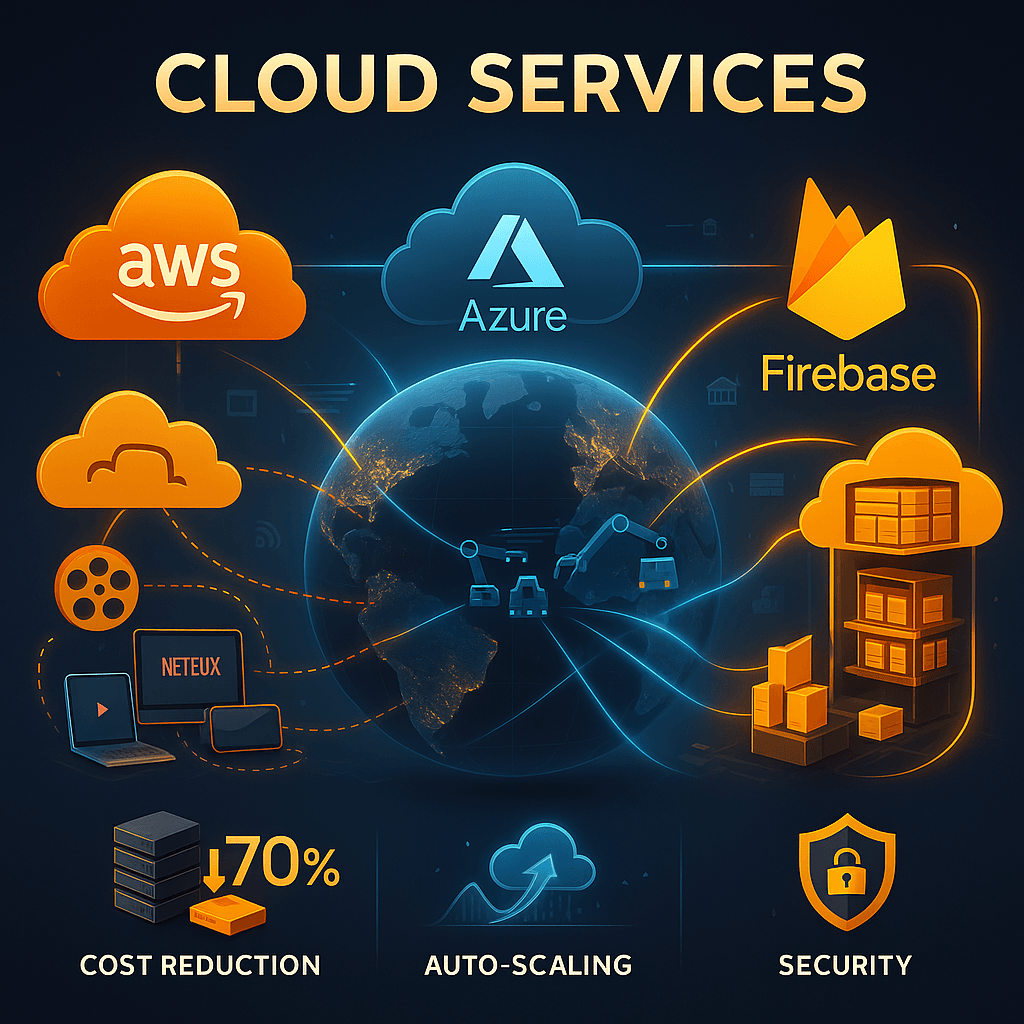
Business benefits:
70% lower infrastructure costs vs on-premise web servers
Auto-scaling during traffic spikes (e.g., ticket sales launches)
Built-in user authentication and data encryption
APIs, Headless CMS, Microservices Architecture
These connectors enable modular, agile web app development.
Application Programming Interfaces (APIs):
Connect payment gateways (Stripe), maps (Google Maps), or social media platforms
Example: Uber uses geolocation APIs to coordinate rides in 70+ countries
Headless CMS (Contentful, Strapi):
Separates content storage from presentation
Unilever manages product info for 100+ localized sites from one dashboard
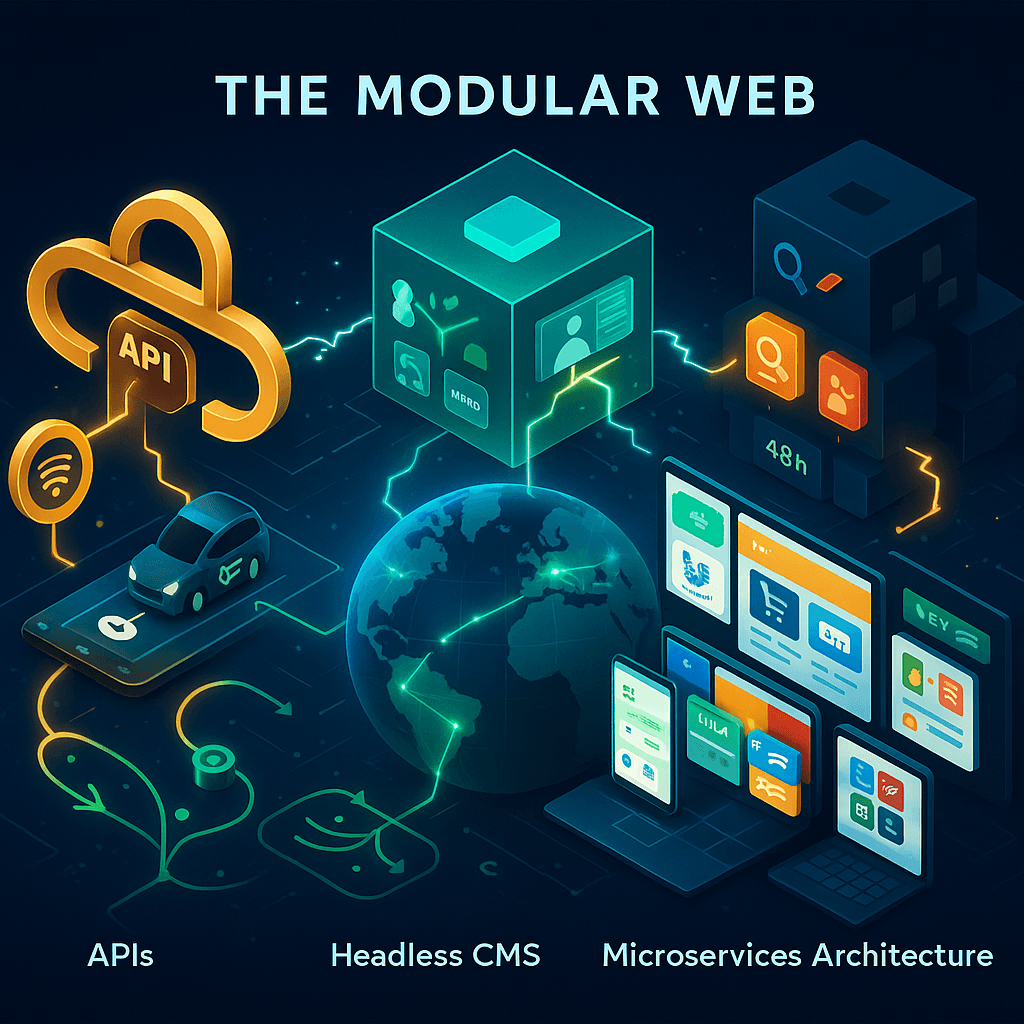
Microservices architecture:
Breaks monolithic apps into independent units (e.g. "search" vs "checkout")
Enables rapid development – teams update one service without rebuilding entire apps
Adidas uses microservices to deploy region-specific promotions in under 48 hours
Development team tools: Version control systems (Git) track changes across microservices
Website App Design and UX Considerations in a Global Business Landscape
For international businesses, web applications must feel local to win trust and ensure a positive user experience. User interface isn't just about looks, it's a bridge across cultures and it needs to be user friendly. Here’s how smart design drives global growth:
Mobile-first & Cross-device responsive design
68% of global shoppers use mobile devices. A European bank lost 30% of Asian users because forms weren’t tappable on small screens.
Best practices:
Use flexible grids that adapt to any screen size
Test on low-end devices common in emerging markets
Prioritize core web vitals (loading under 3 seconds)
After using responsive design, Alibaba found that 75% of sales came from mobile users in 200 countries.
Multilingual UX and Localization
Coca-Cola's "Share a Coke" web app went beyond translation. It showed local names on virtual bottles. This change increased engagement by 25% in Southeast Asia.
Key steps:
Adapt currencies, date formats, and measurement units
Localize imagery (e.g. family photos matching regional diversity)
Use headless CMS to manage 100+ language versions efficiently
Proper localization can double conversion rates in non-English markets (Common Sense Advisory)
Accessibility Standards
Global necessity: 15% of the world lives with disabilities (WHO). Microsoft increased its market share in the EU and Canada by 15%. They did this by making accessibility a key part of their web app development process.
Critical actions:
Follow WCAG 2.1 guidelines (e.g. alt text for images)
Ensure keyboard navigation for motor-impaired users
Offer adjustable font sizes/contrast ratios
Accessible web apps create $6.9 trillion in global spending power
Cultural UI/UX Design
Avoid pitfalls:
Element
Western Interpretation
Asian Interpretation
Red
Danger/Stop
Prosperity/Luck
Thumbs Up
Positive
Offensive in Middle East
Solution: Involve local UX researchers early. When Walmart expanded to Japan, they replaced aggressive CTAs ("Buy Now") with community-focused messaging ("Join Others")
Result: 40% higher user retention in culturally tuned markets.
Business Advantages of Next-Gen Web Applications
Next-gen web apps bring real-world impact to global businesses by enabling faster user interaction, smoother transactions, and more powerful integrations.
Next-gen web apps give global businesses a strong advantage with four main benefits:
Real-time updates & Enhanced customer experience
Modern web apps, such as Shopify, rely on cloud infrastructure like AWS. Modern web apps, such as Shopify, rely on cloud infrastructure like AWS. They use application programming interfaces (APIs) and various programming languages to sync global inventory in just milliseconds. This prevents overselling during cross-border sales events. The results are clear in software development : customer satisfaction is up by 40% (Gartner). Also, repeat purchase rates have increased by 22% due to the smooth user experience. These apps attract users by offering instant interactions. For example, Google Docs allows real-time collaboration.
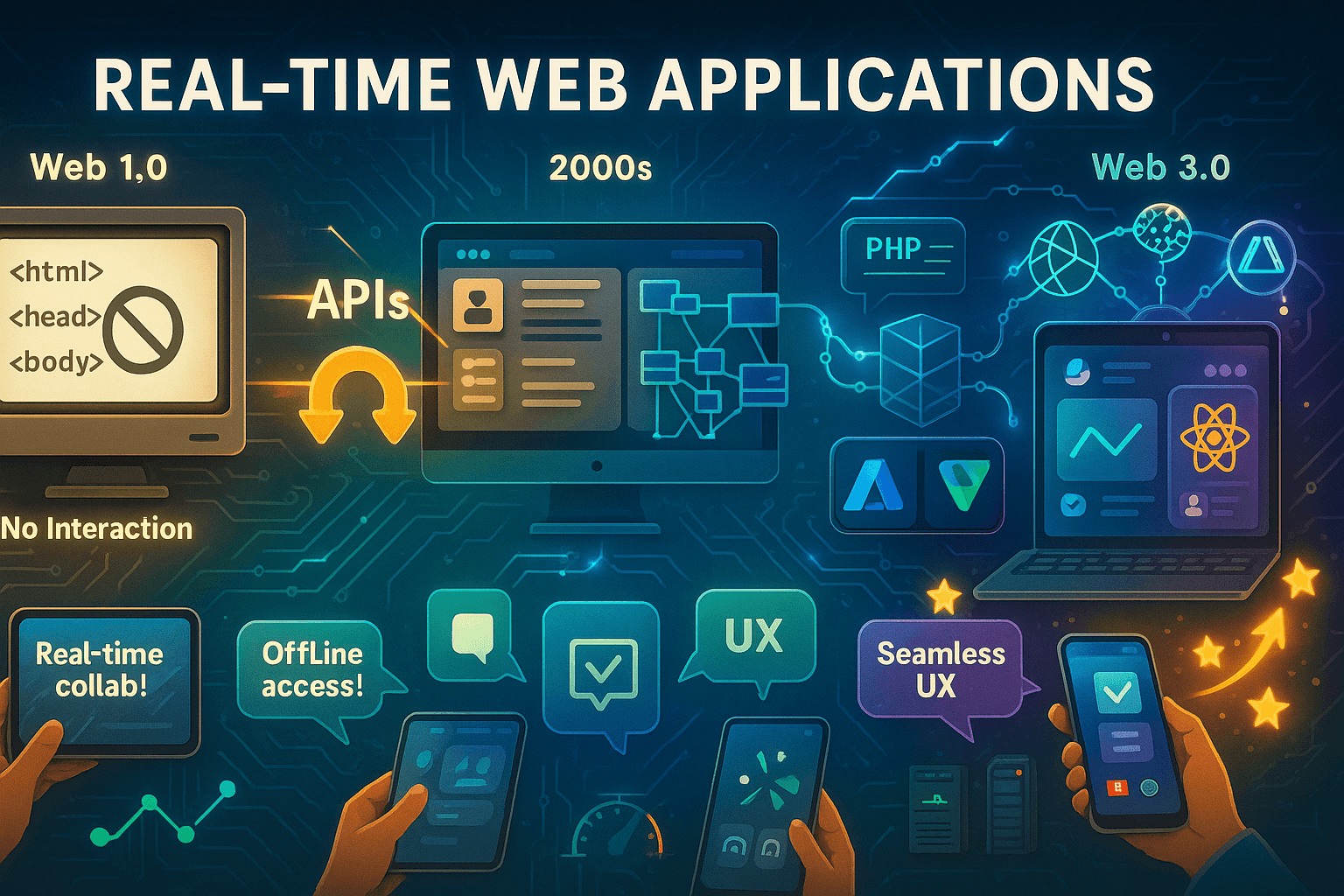
Lower Infrastructure Costs
The shift to serverless deployment (e.g. AWS Lambda) revolutionizes cost efficiency. IKEA saved $1.2 million a year. They did this by paying only for active code execution. This cut out costs for idle web servers.
Unlike traditional setups requiring $220K/year in hardware, serverless needs zero physical infrastructure. Maintenance costs drop from $150K to just $15K annually. This model adjusts itself during busy times, like Black Friday. It keeps performance high without wasting resources.
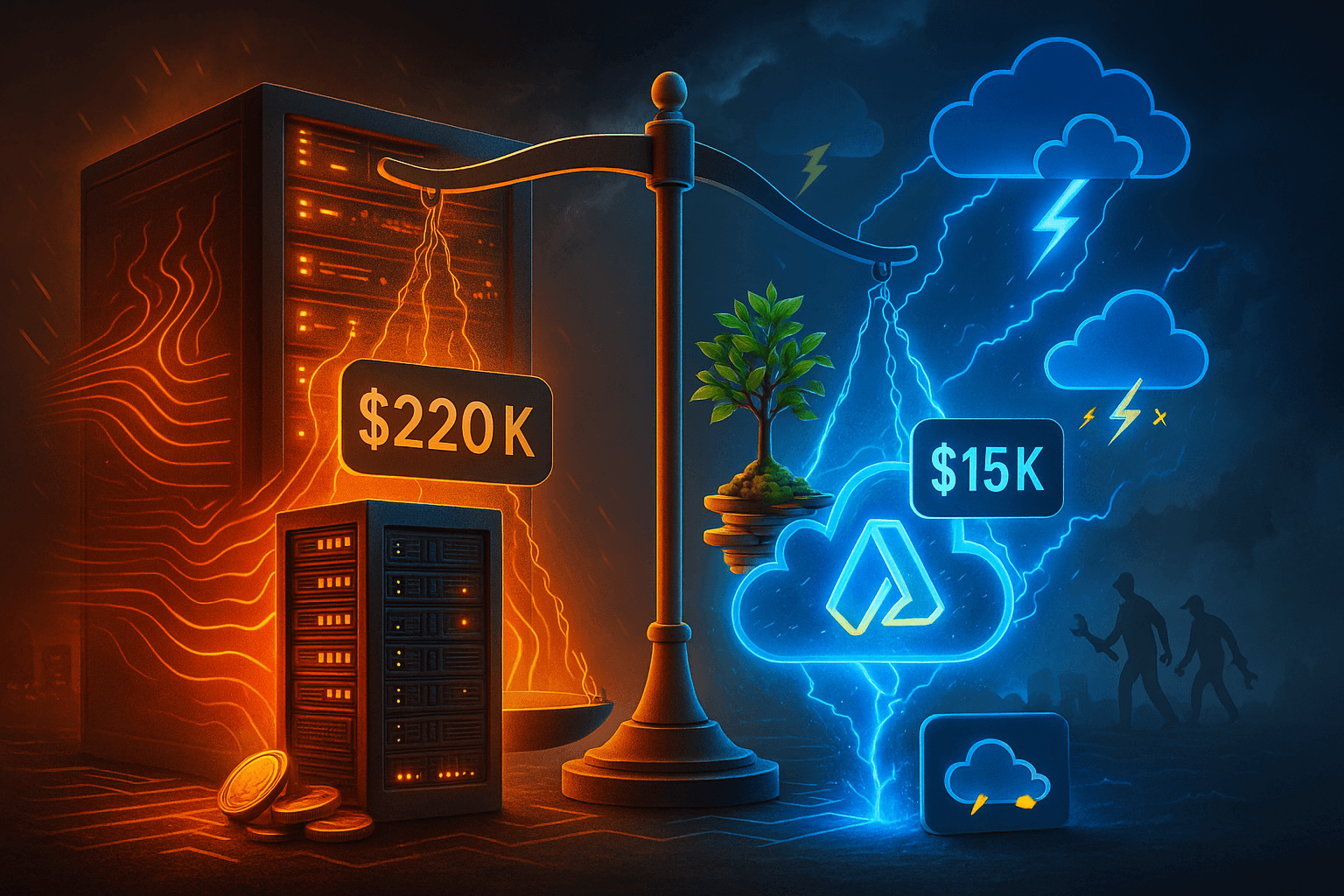
Seamless Integrations
APIs enable web applications to manage global operations with precision. Zara has over 2,000 stores in 96 countries. It connects inventory using application programming interfaces. These sync with Salesforce (CRM), regional payment gateways like India’s UPI and analytics tools. The smooth user experience also includes backend operations. Relational databases keep data safe during billions of cross-border transactions.

Faster Market Entry
Microservices architecture and cloud infrastructure compress international expansion timelines. Spotify deployed in 80 markets in one day by swapping payment/currency modules like building blocks. Traditional web application development required 6-12 months for multi-country launches.
Next-gen web app development takes just 2-4 weeks for building web applications, using reusable microservices and ready-to-go cloud infrastructure. This fast development method helps businesses take advantage of local trends right away. This includes seasonal promotions and new payment options.
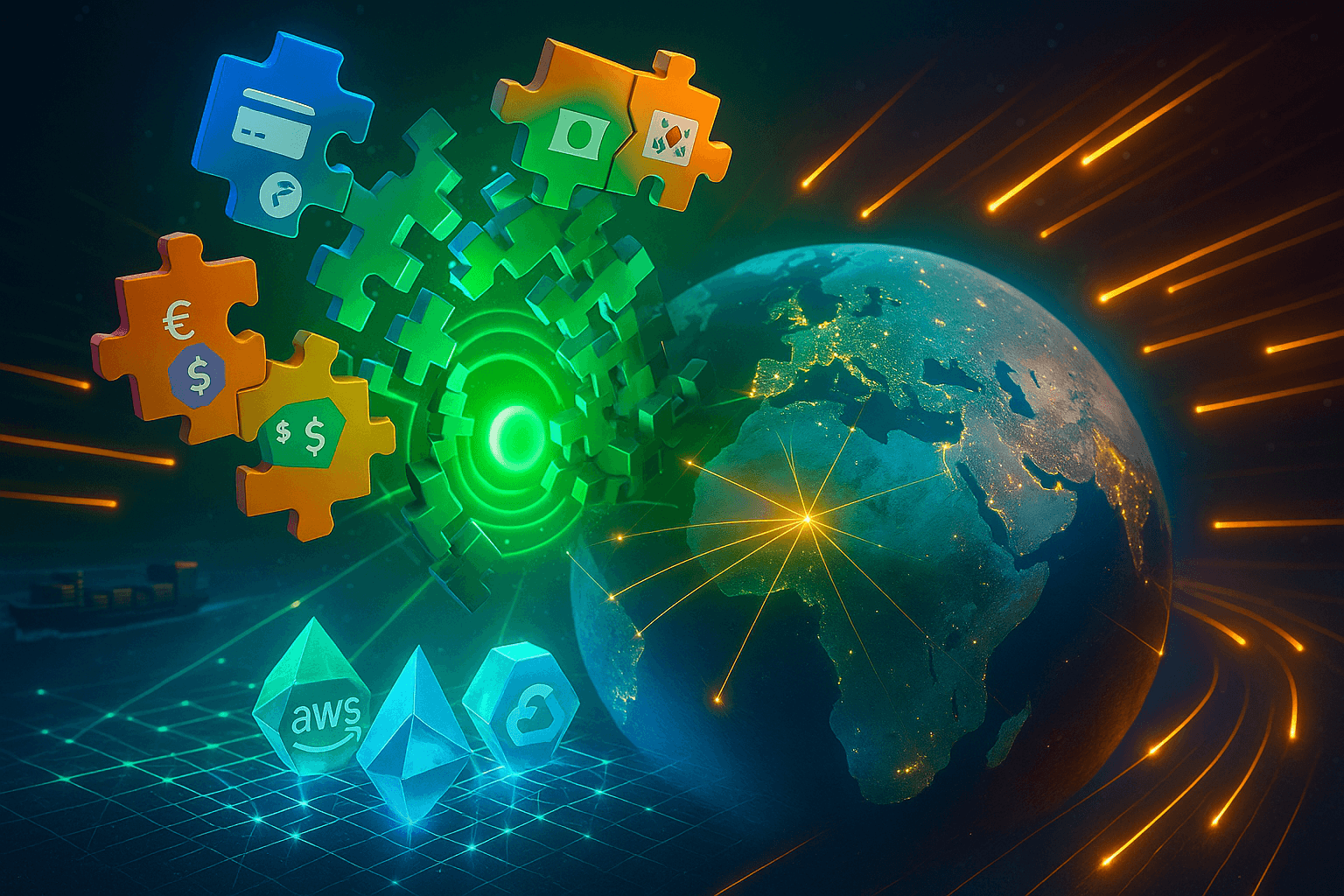
The Future of Web Application Development in International Markets
The global digital landscape never stands still. Web application development races forward, driven by user expectations and technology advances. For businesses that work internationally, grasping these changes is a must. Here’s what’s next:
Progressive Web Apps (PWAs) and WebAssembly
Progressive web applications blend the best of web apps and native mobile apps. They work offline, send push notifications, and install directly from web browsers,no app stores needed. Starbucks' PWA boosted mobile orders by 23%. It allows users to browse menus offline, even in areas with poor connectivity.
WebAssembly (Wasm) changes performance rules. It compiles code from languages like C++ and Rust. This allows it to run almost as fast as native code in browsers. AutoCAD now uses Wasm for its browser-based CAD tools. This means engineers in emerging markets no longer need to download software on their desktops.
Why this matters globally:
PWAs cut development process costs by 50% vs building separate iOS/Android apps
Wasm lets users access advanced tools like 3D modeling and video editing, even on low-end mobile devices.
Both technologies deliver consistent user experience across various devices
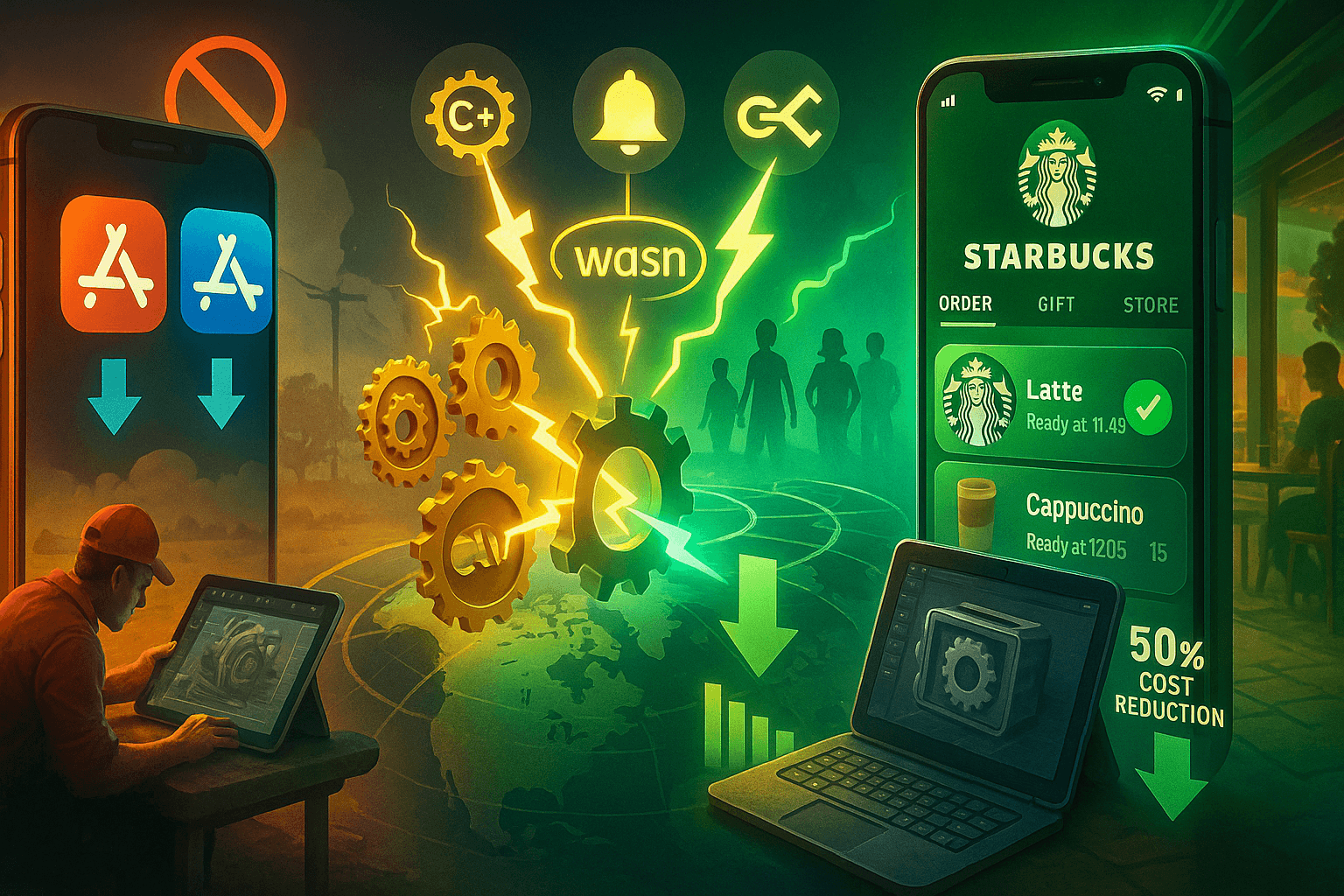
AI-powered personalization and Smart interfaces
Artificial intelligence transforms static web applications into intuitive platforms. Netflix’s AI analyzes user preferences to drive 80% of watched content. Alibaba’s AI-powered "FashionAI" suggests outfits based on local trends in Southeast Asia.
Key innovations:
Dynamic content adjusts in real-time. For example, it can change homepage banners on rainy days in London
Voice-controlled interactive user interfacesfor hands-free navigation
Predictive error resolution (e.g., detecting checkout abandonment and offering live chat help)
For global businesses, AI enables hyper-localization. A travel app could show Kyoto temple tours to Japanese users. It could also feature Cancún beaches for Mexicans. All this can happen in one web application.

Cybersecurity and Privacy in cross-border apps
Data breaches cost businesses $4.35M on average. Stricter regulations (GDPR, Brazil’s LGPD) demand airtight security in web app development, which includes several key aspects :
Critical safeguards:
End-to-end encryption for all cross-border data transfers
Region-specific user authentication (e.g. EU’s Strong customer authentication)
Data integrity protocols like blockchain-based audits (used by Maersk for shipping logs)
BMW’s Southeast Asian sales portal avoided €20M in GDPR fines by implementing:
Data anonymization for test drives
Automated consent management
Localized data storage in AWS Singapore

Regional regulations shaping future web programming
Legal fragmentation complicates global web application development:
Region | Key Regulation | Impact on Development |
|---|---|---|
EU | Digital Markets Act | Requires interoperable APIs |
China | Data Security Law | Mandates onshore relational databases |
India | DPDP Act 2023 | Demands biometric user authentication |
Adaptation strategies:
Modular microservices architecture to swap compliance features
Headless CMS for instant content updates when laws change
Automate testing for region-specific rules (like age verification in Germany)
Conclusion
The future of web application development will focus on intelligent, borderless experiences, which includes building web applications that utilize artificial intelligence, progressive web apps, and adaptive architectures. In contrast, those that hold onto old models may fall behind.
AI-backed personalization paves the way for the creation of meaningful experiences. This means suggesting products that fit local needs. It can also mean adjusting interface layouts to match local mobile devices. Progressive web applications will cut you the hassle of app stores. They also offer more features than other mobile apps. Users in countries with limited connectivity will be happier with these new progressive web applications.
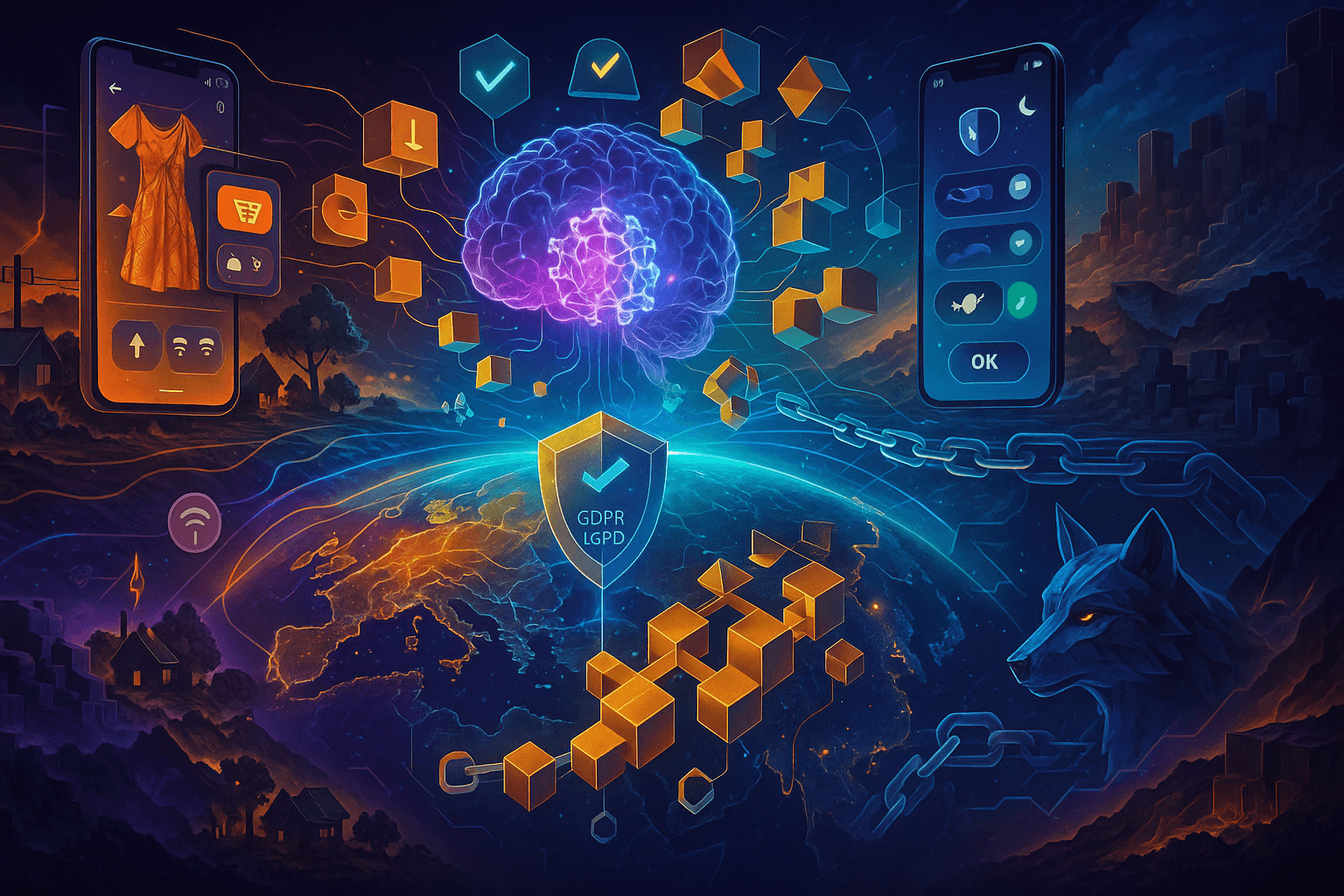
Modular microservices architecture and cloud infrastructure help businesses meet complex regional regulations. They also support rapid development cycles. The key is to combine a seamless user experience with strong cybersecurity and compliance-ready web application frameworks.
As technology advances, global commerce is changing. Businesses that invest in smart web app development now will lead global markets later. These operations can turn geographic diversity into a competitive edge, which is vital for maintaining websites and ensuring performance.
Web Application Development – FAQs
What is the importance of web application development for global businesses?
Web application development builds tools for creating web applications that help businesses grow worldwide. It builds safe platforms for selling products or services anywhere. Companies can use web apps to access global markets. This way, they provide a steady user experience on different devices and browsers.
Web application development builds tools for creating web applications that help businesses grow worldwide. The development process ensures these apps function without issues across countries and devices. This approach boosts international sales and trust.
How is modern web app development different from traditional web programming?
Modern web app development emphasizes dynamic content, real-time updates, and responsive design. Today’s web apps use progressive JavaScript frameworks and APIs. This makes them more interactive than old, static web pages. They use advanced web development frameworks. This ensures smooth performance on all devices and platforms.
What is the future of web application development in international trade?
The future of web development in international trade will include AI for smart translations. It will also focus on ensuring compliance with local laws. Progressive web apps can work offline. This helps people in remote areas stay connected without interruption. These advancements will allow businesses to operate without borders. This will make global trade more efficient and inclusive.
Why is website app design crucial for international audiences?
Effective website app design considers cultural traits, language preferences and device compatibility. Effective website app design considers cultural traits, language preferences and device compatibility. Businesses can create a consistent user experience by focusing on easy-to-use interfaces and engaging in web development best practices. They should also optimize for different mobile devices. Ignoring these aspects can lead to decreased user engagement and hinder global reach.
Which web app software is ideal for scaling a global business?
Frameworks like React and Django are used for building scalable web applications. They help millions of users. They use cloud infrastructure and follow the Model-View-Controller architecture. It supports web-based applications in any time zone. These technologies help speed up development. They also keep data safe and improve performance in different time zones.
How can companies benefit from web design and development strategies?
Smart web design and development, along with the necessary technical skills, keep users coming back. It makes apps easy to navigate and fun to use. Adding interactive elements and improving core web vitals makes the user experience better. This beats competitors in crowded markets. Strong web application development turns visitors into fans. These practices boost search engine results and increase customer satisfaction.
Is Python web development suitable for international web applications?
Python, especially with Django, is great for building strong web applications. Python, especially with Django, is great for building strong web applications that can manage high traffic and support many programming languages and currencies. It supports many languages and currencies smoothly. Updates roll out fast without crashes. This makes web applications reliable for global users.
Comments
Your comment has been submitted successfully!